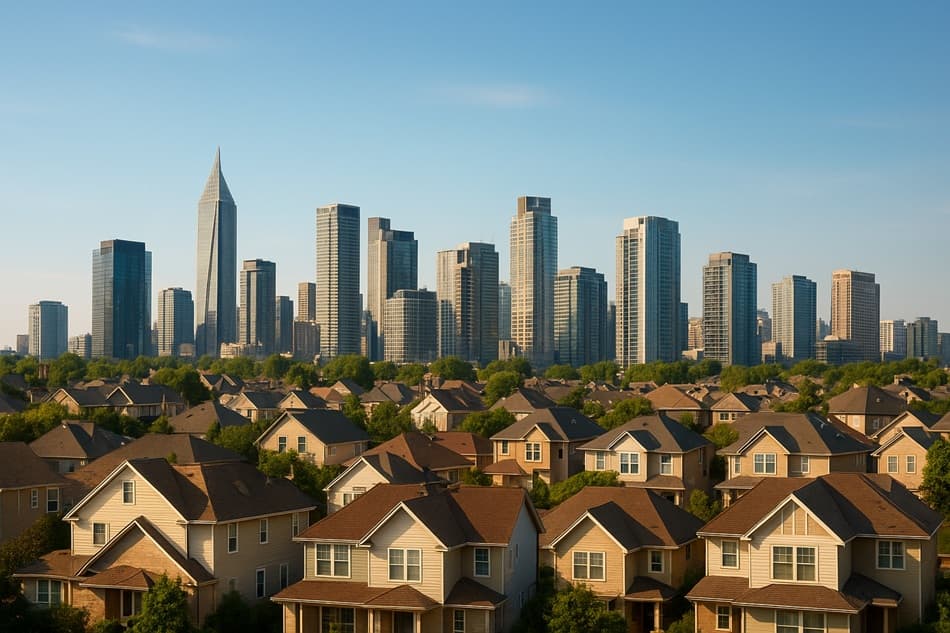Ask GRAI Anything
Your Real Estate Questions, Answered Instantly via Chat


Help us make GRAI even better by sharing your feature requests.

For years, policymakers, economists, and homebuyers have been waiting for the “reset.”
For housing prices to fall.
For affordability to come back.
But it’s time to face reality: that reset isn’t coming.
Even if interest rates ease in 2026, the fundamentals driving global housing prices - constrained supply, structural demand, and global capital flows - aren’t going anywhere.
Affordability, as we once knew it, has permanently changed.
And the people who win in this new era of real estate aren’t waiting for the old system to fix itself. They’re adapting to the new one.
In the decades following World War II, home prices tracked wage growth fairly closely. Then, around 2020, that link snapped.
United States: Median home prices have surged 43% since 2019, while median household income rose only ~14% over the same period.
Canada: Average home prices are now 11x median household income, double what most economists view as sustainable.
United Kingdom: Affordability is the worst in 150 years, with the median house now costing over 8.8x average annual income.
India: Property inflation outpaced income growth by 2.4x in top metros like Mumbai, Bengaluru, and Hyderabad.
Even as borrowing costs rise, prices haven’t fallen meaningfully. In fact, higher rates have ironically made prices stickier - keeping existing homeowners locked in low-rate mortgages and choking new supply.
Related: Mumbai Real Estate 2025: Prices, Predictions & AI Insights
Even if the Fed and ECB cut rates in 2026, it won’t be enough to restore balance. Here’s why:
1. Supply Is Fundamentally Broken
The world is underbuilt - badly. The U.S. housing shortage stands at 4.5 million units (Freddie Mac, 2025). Europe faces a similar deficit, worsened by aging housing stock and slow permitting.
2. Land and Zoning Bottlenecks
Local zoning restrictions and anti-density sentiment prevent housing from being built where people actually want to live. In Toronto, 70% of residential land remains zoned exclusively for single-family homes.
3. Global Capital Outruns Local Incomes
In an era of global liquidity, real estate has become an asset class, not just shelter. Money moves faster than policy - from Hong Kong to Dubai, from Toronto to Lisbon - chasing political safety, currency hedges, and yield.
4. Climate and Insurance Costs
Three straight years of $100B+ global insured catastrophe losses have made insurance a luxury in flood and fire zones. When land becomes uninsurable, the remaining stock rises in value.
5. Demographics Don’t Reverse
Millennials and Gen Z are the largest potential homebuyer base in history. Even if just half of them attempt to buy, the demand shock persists for decades.
Rate cuts are coming - likely small, cautious, and too late to restore true affordability. When rates drop, pent - up demand will return faster than supply can respond. Developers are still battling higher construction costs, and banks remain cautious on lending.
Expect the following as 2026 unfolds:
A brief cooling period, followed by renewed price acceleration in supply-starved metros (Austin, Dubai, Bengaluru).
Rent inflation easing modestly but staying well above pre-pandemic averages.
Premium housing dominates new development pipelines, leaving the affordability gap intact.
In short, lower rates won’t save affordability - they’ll just reignite competition.
The smartest buyers aren’t waiting for a mythical correction. They’re adapting through strategy, flexibility, and data.
1. Going Micro, Not Macro
They aren’t asking, “Should I buy now?” - they’re asking, “Where exactly does the math still work?”
Example:
Model price trajectories for 2BHK apartments in Navi Mumbai vs Pune suburbs after Metro completion.
Forecast 5-year ROI for secondary U.S. metros like Raleigh or Tampa vs national averages.
2. Geo-Arbitrage - Rent in Tier-1, Buy in Tier-2
High-income professionals are renting in expensive global hubs (London, Singapore, Dubai) and investing in lower-cost, higher-yield markets nearby.
Example:
Compare ROI of renting in Singapore while buying a condo in Kuala Lumpur.
Simulate yield from renting in Toronto but owning in Halifax.
3. Buying Smaller, Smarter, and Greener
Micro-units, energy-efficient homes, and fractional ownership are becoming mainstream. “Bigger” no longer means “better” - liquidity does.
Example:
4. Leveraging Data and AI Before Capital
The biggest change in 2025 - 2026 isn’t policy. It’s intelligence.
Instead of chasing speculation, savvy buyers are using AI models to understand how policy, inflation, and migration will shape local housing ROI - before making a move.
Example:
Model affordability changes in Dubai if expat inflows rise 10% and mortgage rates fall 50 bps.
Simulate rent-to-income ratios across European capitals under different wage growth assumptions.
Must Known: Dubai Real Estate Market in 2025: The Ultimate Investor's Guide with GRAI
GRAI isn’t about hype. It’s about clarity.
With GRAI, you can simulate the real estate market dynamics that matter - not national averages, but local realities:
“What happens to affordability in London if rates drop 1% but immigration rises 10%?”
“Forecast ROI on Dubai vs Singapore condos under variable rent-yield scenarios.”
“Estimate breakeven for renting vs buying in Austin under a 25% insurance premium increase.”
Affordability isn’t coming back because the system isn’t broken - it’s evolved.
Supply is constrained. Demand is structural. Capital is global.
For younger generations, that means mobility beats mortgages.
For investors, it means data beats timing.
And for everyone else, it means you either learn to model the new reality - or get priced out by those who already are.